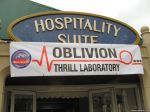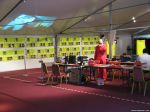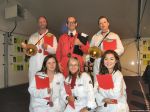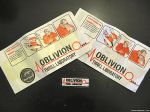Alton Towers Almanac
Please note that Alton Towers Almanac is no longer maintained or updated, and almost all information will be out of date.
For the latest information, please visit Alton Towers’ official website.
ATA › Features › Featured Articles › Oblivion Thrill Experiment 2007
Friday 21st September 2007
Brendan Walker and his team of Thrill Engineers have been at the park for three days (19th - 21st September), to test the reactions of those brave enough to ride the world's first vertical drop roller coaster, Oblivion.
Volunteers were linked up to a heart monitor, accelerometer, face-camera and a galvanic skin response sensor while going on the ride.
Each day had three sessions, each with eight volunteers. Each volunteer had to go through a series of tests to measure the thrill factor and the experience factor that they expect. This took place in the shape of psychological profiling to assess the thrill-seeking tendencies of each rider.
Other tests included a ride on Oblivion with each volunteer wearing a helmet camera to capture facial expressions, with volunteers also asked to provide an audio commentary whilst on the ride.
Back in the lab, riders' videos were reviewed, and a brief explanation of the results were given.
The thrill seekers also had to take part in a spot the difference competition to assess focus and concentration, and were also photographed whilst displaying "fake emotions".
Experts at the University of Nottingham's Mixed Reality Lab (MRL) designed and implemented the biofeedback and recording technology for the Thrill Laboratory.
Whilst taking part in the Thrill Experiment, I had the opportunity to catch up with the man behind the study, Brendan Walker.
I asked him exactly what the Thrill Laboratory was: "We've been working with eighty riders on Oblivion at Alton Towers, doing the UK's largest study on thrill seekers on roller coasters."
So what were the volunteers subjected to during their time with the Thrill Laboratory? "We've been conducting a series of psychological experiments to find out how much of a thrill seeker each volunteer is and how unstable they are emotionally, so all different aspects really.
"Mainly though, we've been doing experiments on the ride by kitting up the volunteers with a camera to monitor their facial expressions, which will give us a good indication of their levels of pleasure. We've also been using heart rate monitors and galvanic skin response sensors, which is a little bit like a lie detector test, to see how stressed people become whilst riding Oblivion. We have also used an accelerometer to measure the forces that are being exerted on the body."
When asked what he would like to achieve from the results, Brendan said: "We're hoping to uncover how different types of thrill seekers and different types of riders respond to the same ride features, so on Oblivion, how different people have different thrill seeking levels on the same drop. So by being able to study one ride, with lots of different riders, it will give us a great insight into how effective the design is, and then in future use that information to help us to design greater thrill rides."
I asked Brendan whether he thought that his three days at Alton Towers had been a success? "The three days have been very successful, just from the amount of interest in the project, and the enthusiasm that the volunteers have showed has been just phenomenal. Everybody knows that on rides, you are being pushed to your physical limitations, and it's interesting for people to see how they're also being pushed to their physical limitations. I'm interested in what makes them tick as a rider."
Did he find that the participants in this Thrill Experiment tended to be quite similar? "We've had a wide demographic of people. We've had a couple who were in their sixties from Cornwall who've ridden Oblivion over two hundred times, all the way through to a guy from Ireland who's never ridden Oblivion before, or any other roller coaster for that matter - he was a complete roller coaster virgin! So we've had a complete spectrum of people, which is fantastic for our study. We don't just want enthusiasts, we want to encourage bringing new riders into the fun of riding roller coasters."
I asked what he expected from the results, and if there were any early trends emerging from them? "We expect to see some trends in the results, higher sensation seekers love the high adrenaline rides like Oblivion, but the people who score high on experience seeking prefer non-coaster attractions, like Hex for example, which is heavily themed. Then we can correlate that with their actual results from their experience on Oblivion. We are finding that genuine thrill seekers are a lot more calm and collected on Oblivion."
Would Brendan be interested in doing another experiment like this in the future? "I think on the success of it, we would like to study a variety of riders on different rides and start, hopefully, to effect the design of future rides."
Finally, I asked Brendan how he saw the future of thrill rides. "It's not rocket science, we need to be doing more to be shocking future riders, but at the same time, we don't want to put off the lower thrill sensation seekers. It's about finding the right balance, and that's the hard bit.
"We need to create interactive rides that adapt to individual riders, so that each experience Is different. That's where I think the future developments will be heading, and that's what the results can be used for."
Rich Holmes




